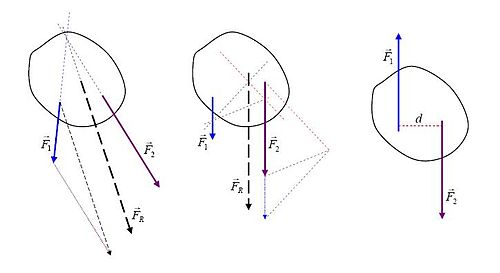
Back قوة محصلة Arabic Statische Äquivalenz German Equivalencia estática Spanish Resultantti Finnish Rezultanta Croatian Eredő erő Hungarian പരിണതബലം Malayalam Daya paduan Malay Resultant i fysikk NN Equivalência estática Portuguese
This article needs additional citations for verification. (June 2020) |

In physics and engineering, a resultant force is the single force and associated torque obtained by combining a system of forces and torques acting on a rigid body via vector addition. The defining feature of a resultant force, or resultant force-torque, is that it has the same effect on the rigid body as the original system of forces.[1] Calculating and visualizing the resultant force on a body is done through computational analysis, or (in the case of sufficiently simple systems) a free body diagram.
The point of application of the resultant force determines its associated torque. The term resultant force should be understood to refer to both the forces and torques acting on a rigid body, which is why some use the term resultant force–torque.
The force equal to the resultant force in magnitude, yet pointed in the opposite direction, is called an equilibrant force.[2]
- ^ H. Dadourian, Analytical Mechanics for Students of Physics and Engineering, Van Nostrand Co., Boston, MA 1913
- ^ Hardy 1904, p. 23.
© MMXXIII Rich X Search. We shall prevail. All rights reserved. Rich X Search